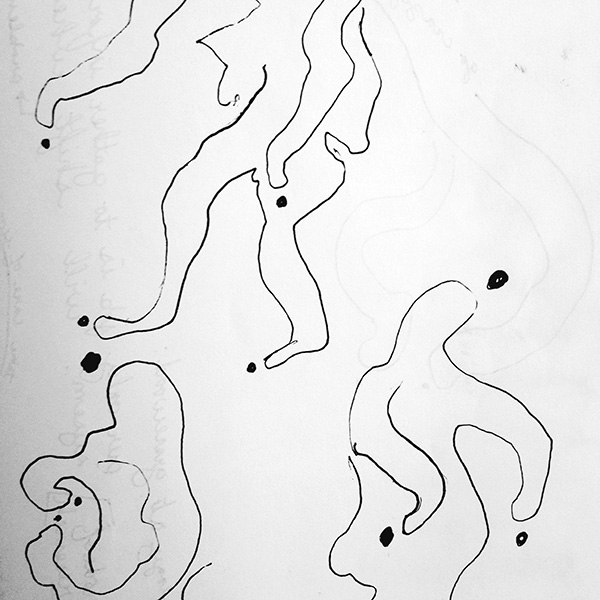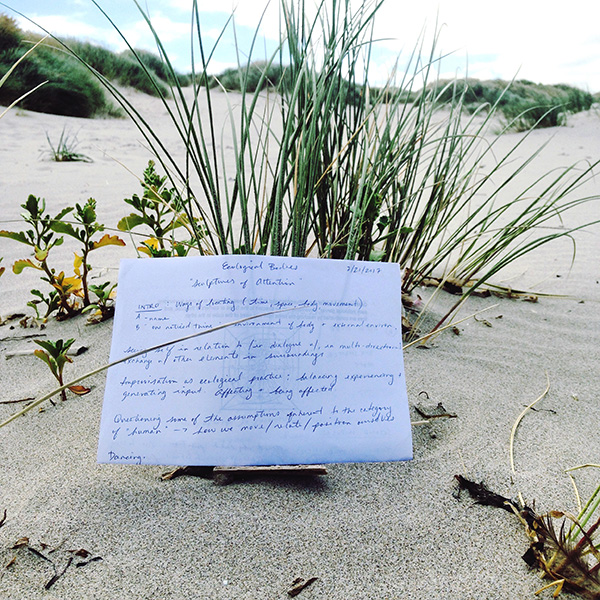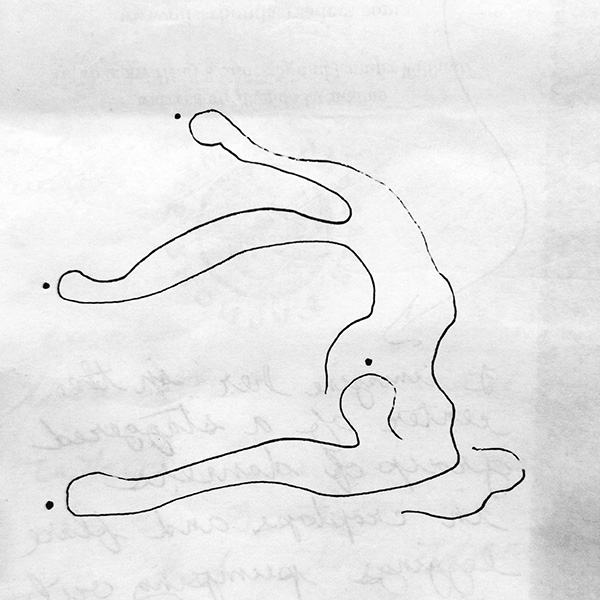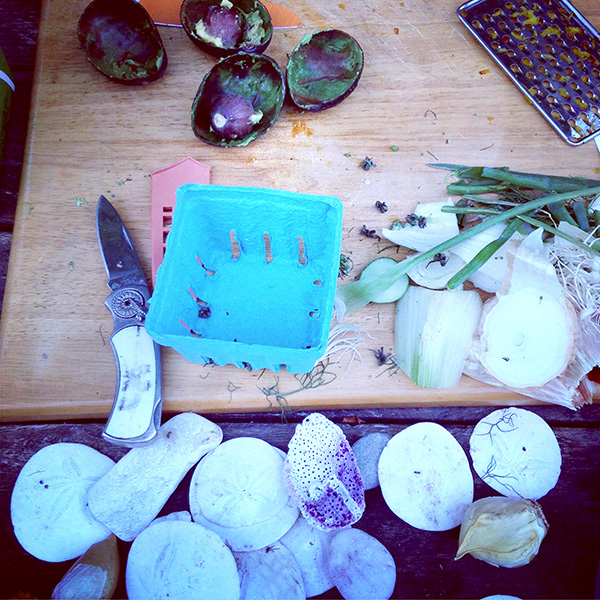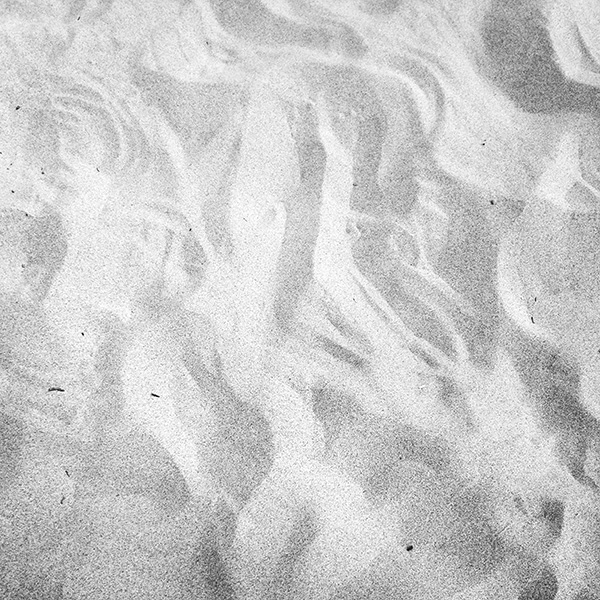A Conversation About Everything in Relation to Everything
BY HANNAH KRAFCIK
If you search the term “ecology” online, you will get “the branch of biology that deals with the relations of organisms to one another and to their physical surroundings.” For a little over a week, several movers gathered together for Ecological Bodies: a week of somatic inquiry – an event which took place partially in Portland, Oregon through public workshops, and partially at the Oregon Coast during an artist retreat. The below conversation between Emily Jones and myself, co-founders of Ecological Bodies, and Zena Bibler, one of the visiting artists, mulls over the movement-based, improvisational practices that ignited our thinking.
In reflecting on this research-based week of dance, we found the term “ecological” to be almost arbitrary, as our thinking shifted toward the larger notion of “everything in relation to everything.” Our learning seemed to emerge through the process of questioning assumptions and dismantling certain value sets in relation to dance – but, more so, in relation to our lived experiences. This has become a call to locate ourselves within the context of our lives.
~~
Hannah Krafcik: I’m going to start with a simple question, which is: What do we think the value for us is in a research-based week of practice, as opposed to a week of rehearsal leading into performance?
Zena Bibler: I think the rhythm is different, in terms of what happens after a research-based week versus a performance-festival week. When I’m making a performance, I feel like I’m in an intense incubator. Everything leads up to the performance, and minutes after it’s over I’m stuck with the question, “What do I do now that it’s finished?” There’s a let down or vacuum. I think a research week feels more like an open-ended experience where there can be multiple peaks and insights, as opposed to one that reaches a climax, and then dumps out. Brandin Steffensen has referred to performances as “drains” – where a practice can continue until it dies or goes down the drain of performance.
Hannah: Now that Ecological Bodies is over, I’m left with the insights that participants in the workshops have shared. I think that Emily and my job, as co-producers, is to consider and synthesize these insights to the best of our abilities. But, in tandem with this, I also wonder how to move further away from promoting things (like Ecological Bodies, or dance classes, or performances) as finite offerings to be consumed or experienced. I’ve been thinking about our value statement for the week, which doesn’t tangibly exist yet but, if it did, might have included something about investment in process over product.
Emily Jones: For me, many of the themes that have been brought up this week in our movement research are a microcosm of larger concepts. We have been investigating our socialization, particularly around how we sense and perceive our environments, and the things within our environments. Though we have been in contained spaces and in contained groups, the things I have been thinking about are relevant to my personal habits, and perspectives of society at large. These practices have highlighted things that are reflected in all parts of my life.
Hannah: This leads me to another thought about an ongoing theme from this week, which is continuity. What is continuity of these practices, as it shows up in the theory we’ve been considering, and even in concepts like the spiral, something closely examined in Axis Syllabus? I think about the organic geometry and physics of a spiral as never-ending, a continuous pathway for accumulation of momentum that is available to me, physically, but also perhaps metaphorically. I want to posit the idea of continuity into the mix as well.
Zena: To me, the artist retreat to the Oregon Coast felt very different from the rest of the week. I only experienced part of the week of Ecological Bodies workshops, but the retreat, and the fact that everyone on the retreat shared some part of a collective experience, made the container we created emerge as a thing that could be looked at its own right. For example, by getting to know someone through spending more than two hours with them – how is the group an example of the ecologies we are intending to study?
Emily: Multiple rituals emerged because we were having this collective and collaborative experience with the group…
Zena: The phrase “dropping in” also came up in my conversations with one of the participants, a term sometimes used in festivals, contact improv jams and dance classes. I understand it to describe the feeling of “dropping” into some separate rhythm. This week it occurred to me that what was happening was something different than momentarily “dropping in.” Instead, it felt like a longer accumulation of experiences and information shared and revealed over time. It reminded me of the ecosystem metaphor – something evolving and responding to context and conditions.
Hannah: What if this notion of “dropping in” is just the act of paying attention?
Emily: Or having (or being able to set aside) enough time? So often in our day-to-day dance practices, we come from some place completely exterior, and then we show up for a block of two hours. It’s like, “Okay, this is it!”
Hannah: It has been so nice to work with you, Zena, because I feel like you really do hold performative space in your day-to-day through things like your morning ritual. We talk a lot about performance in our work together. In my own life, I wonder if perhaps “performance” just involves honing a little bit more attention around things I am swirling in daily, so that everything can be part of a different system of meaning-making, outside of (supposed) systems of meaning-making that society asks me to strive for.
Zena: I’m always fascinated by how often the most compelling performances (for me) are these crazy moments of spontaneous synergy during dances, like watching what happens when someone steps up in a dance circle. My definition of performance encompasses these things. There’s this allowing of something to be special by just allowing it to be seen. I did feel that element of performance this week.
Hannah: Having been part of performances with you, I know you encourage this idea that we’re not just allowing ourselves to be seen, but we’re also engaged in the act of seeing. We talked about this idea of “location” – experiencing and generating at the same time as a way of “locating” oneself in time and space.
The concept of “tuning” is so helpful for that – tuning into what I’m seeing; tuning into the impacts of whatever it is I’m generating; tuning as a way of understanding what’s happening in order to deepen my understanding of context. In considering postcolonial discourse, tuning takes on a sense of urgency for me, e.g. tuning into a different frequency because there might be a drastically different narrative of what’s happening. What am I missing when I neglect to do this work?
Emily: This makes me think of our practice this morning, when we removed use of codified language. It was an exercise in taking away our primary mode of communicating, which made us go to a “secondary” level of communication. I’m curious about how, in other circumstances, we can take away our primary understanding of a situation?
Zena: That would be an amazing way to work – just removing our primary way of understanding something.
Hannah: That leads me to another question I’ve been asking myself: How can I redefine “understanding” and “knowing” as a call to continually deepen experience and grow in my learning. I am thinking about this redefined version of “understanding” and “knowing,” as opposed to the version that says, “I know what this is. I can defend my position on this, because this is what I know, and this is where I learned this stuff, and this is who I learned it from (and whatever else I might say to try to hold on to power in any given situation).” How can I redefine this for myself, so that it’s an understanding that’s never fixed but always reaching and developing.
Emily: That makes me think of how in Spanish there are two verbs for “knowing;” one of them is saber and the other is conocer.
Zena: Saber is like “reading” (in a book) or being familiar with…
Emily: …and conocer is “being acquainted with” in a personal sense – actually experiencing, or seeing firsthand. Sometimes I “know” because I hear about or talk about, and then other times I know because I experience. Maybe those things are too closely lumped together, even though they are very different. Instead, there might be a spectrum of knowing.
Hannah: I think that’s a great thing about performance too. As a performer, I might think I know A, B and C, and I might think that I’m positioned in a particular way. But every experience I have in a performative context undermines these assumptions and highlights my own subjectivity. How do I negotiate the gray space?
Zena: For me, it comes back to position. Where is the audience positioned? That’s what the audience knows of the piece, along with information gleaned or absorbed from where they’ve been positioned in the past.
Emily: Yes, history is important. This is true with how we interact with others as well. In the retreat portion of Ecological Bodies, each person had their own experience in relation to the people around them. Some of the people I knew well; others I was just meeting. Noticing the whole ecosystem was part of the collective experience.
The practice of noticing or observing is one way of knowing. I think about this when I’m around my dad (who lives on rural land) in places where he’s very familiar. He looks at the river every day, watching for changes, observing subtle shifts. For him, it’s very functional; he wants to catch a fish! Still, I think there’s some wisdom in treating an environment in a way that doesn’t impose expectation.
Zena: I think the strongest thing, for me, was the practice of not nodding or confirming someone when listening to them speak. In practice, I saw how even saying something in agreement (“right!”) could keep the speaker from sharing further nuance of that thought.
The other practice that I felt drawn to was the practice of proceeding without knowing what comes next, but, instead, feeling what’s possible. That has revolutionized my experience of dancing. This “not having to know” reminds me of Jeanine Durning. The title of her piece I just participated in at UCLA is “we will be there when it happens.” Her work is based on a pact to keep going once you start, that you’re not going to let anything stop you, and you’re going to notice as much as possible. That’s what sustains you – noticing more.
Emily: This makes me think the practice of acting on your second instinct is very constructive. I think it’s interesting in both directions because, with my second notion, I’m not acting on my first instinct, which is maybe the more known thing, but I’m also not waiting until the fourth or fifth time an impulse arises to act. It goes both directions.
Zena: It also seems like there’s a link between the practice of proceeding-without-knowing (but feeling/observing) and the practice of not assuming I know what a person I’m talking to is talking about (and, thus, not confirming it with a head nod or a “yeah”). When I’m listening to someone, I often feel compelled to respond, but I think that both of those things – the sense of follow through and the sense of needing to respond in conversation because that’s “what listening is” – really does foreclose on so many possibilities. When I’m dancing in a space that is not open-ended, this similarly forecloses many possibilities.
Hannah: What you said about Jeanine’s work makes me think of the practice of life. My body is a constant reaction, constantly in motion. Form comes out of motion (as per Jaap van der Wal’s study of Embryology). With that, I wonder how to keep moving without adhering to the idea that I must keep producing quantifiable outcomes in a society that demands them for survival.
At this point in the conversation, we began the process of creating a list of people whose practices and insights influenced our work in Ecological Bodies, as well as our own movement practices. The list below is only a surface-level index of some practices we have shared, and, for us, this list has lead to more questions about the lineages of these sources—their history, geography, political and cultural contexts, etc. The learning continues:
- Luciana Achugar’s Please Project and idea of sensing the world without knowing or naming anything
- Linda Austin and Performance Works Northwest
- Ayurveda and the notion that the act of noticing can help one prepare for life
- Bisceglie, who believes that dance can “take it on”
- Christian Burns and the concept of living in improvisation
- Barbara Dilley and Contemplative Dance Practice
- Jeanine Durning and nonstopping
- Body-Mind Centering
- Frey Faust, Axis Syllabus, and a healthy resistance to codification
- Ka’ila Farrell-Smith and decolonizing the settler colonial lens
- Emily’s father
- Fleet Moves Dance Festival and the many past collaborators on that project, including Kathryn Schetlick and Brandin Steffensen, who committed to “thing-ness of the thing” in movement research
- Tahni Holt and FLOCK Dance Center
- Malinda LaVelle and Project Thrust
- Lisa Nelson and Tuning Scores
- Taisha Paggett and her score “Lifting the Heroes”
- Summer Lee Rhatigan and ballet as a practice of living
- Mickey Sanchez and dismantling the heteropatriarchy through incessant curiosity
- Nancy Stark Smith, contact improvisation, and the practice of telescoping awareness
- Mary Starks Whitehouse and Authentic Movement
- Carolyn Stuart and an anti-institutional approach to contact improvisation
- The practice of surfing
- Jaap van der Wal and his research into embryology and phenomenology
Read the prologue to Ecological Bodies here, and stay tuned for an epilogue that is already in the process of arising in a to-be-determined location.

